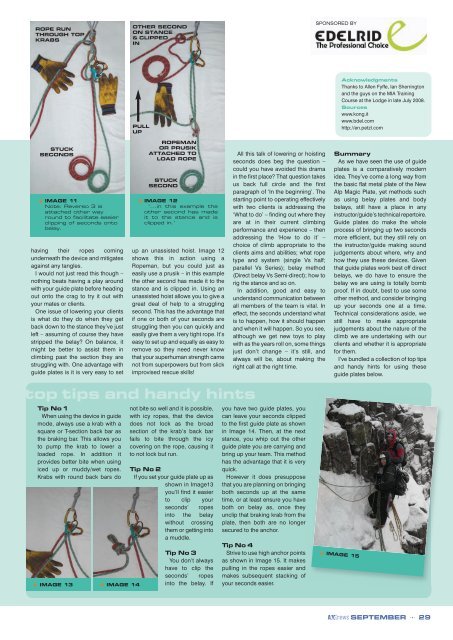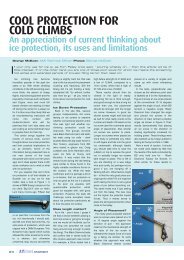WHAT'S SO MAGIC ABOUT MAGIC PLATES? - Glenmore Lodge
WHAT'S SO MAGIC ABOUT MAGIC PLATES? - Glenmore Lodge
WHAT'S SO MAGIC ABOUT MAGIC PLATES? - Glenmore Lodge
Create successful ePaper yourself
Turn your PDF publications into a flip-book with our unique Google optimized e-Paper software.
ROPE RUN<br />
THROUGH TOP<br />
KRABS<br />
STUCK<br />
SECONDS<br />
▲ IMAGE 11<br />
Note: Reverso 3 is<br />
attached other way<br />
round to facilitate easier<br />
clipping of seconds onto<br />
belay.<br />
having their ropes coming<br />
underneath the device and mitigates<br />
against any tangles.<br />
I would not just read this though –<br />
nothing beats having a play around<br />
with your guide plate before heading<br />
out onto the crag to try it out with<br />
your mates or clients.<br />
One issue of lowering your clients<br />
is what do they do when they get<br />
back down to the stance they’ve just<br />
left – assuming of course they have<br />
stripped the belay? On balance, it<br />
might be better to assist them in<br />
climbing past the section they are<br />
struggling with. One advantage with<br />
guide plates is it is very easy to set<br />
OTHER SECOND<br />
ON STANCE<br />
& CLIPPED<br />
IN<br />
PULL<br />
UP<br />
ROPEMAN<br />
OR PRUSIK<br />
ATTACHED TO<br />
LOAD ROPE<br />
STUCK<br />
SECOND<br />
▲ IMAGE 12<br />
‘...in this example the<br />
other second has made<br />
it to the stance and is<br />
clipped in.’<br />
up an unassisted hoist. Image 12<br />
shows this in action using a<br />
Ropeman, but you could just as<br />
easily use a prusik – in this example<br />
the other second has made it to the<br />
stance and is clipped in. Using an<br />
unassisted hoist allows you to give a<br />
great deal of help to a struggling<br />
second. This has the advantage that<br />
if one or both of your seconds are<br />
struggling then you can quickly and<br />
easily give them a very tight rope. It’s<br />
easy to set up and equally as easy to<br />
remove so they need never know<br />
that your superhuman strength came<br />
not from superpowers but from slick<br />
improvised rescue skills!<br />
top tips and handy hints<br />
Tip No 1<br />
When using the device in guide<br />
mode, always use a krab with a<br />
square or T-section back bar as<br />
the braking bar. This allows you<br />
to pump the krab to lower a<br />
loaded rope. In addition it<br />
provides better bite when using<br />
iced up or muddy/wet ropes.<br />
Krabs with round back bars do<br />
▲ IMAGE 13<br />
▲<br />
IMAGE 14<br />
not bite so well and it is possible,<br />
with icy ropes, that the device<br />
does not lock as the broad<br />
section of the krab’s back bar<br />
fails to bite through the icy<br />
covering on the rope, causing it<br />
to not lock but run.<br />
Tip No 2<br />
If you set your guide plate up as<br />
shown in Image13<br />
you’ll find it easier<br />
to clip your<br />
seconds’ ropes<br />
into the belay<br />
without crossing<br />
them or getting into<br />
a muddle.<br />
Tip No 3<br />
You don’t always<br />
have to clip the<br />
seconds’ ropes<br />
into the belay. If<br />
All this talk of lowering or hoisting<br />
seconds does beg the question –<br />
could you have avoided this drama<br />
in the first place? That question takes<br />
us back full circle and the first<br />
paragraph of ‘In the beginning’. The<br />
starting point to operating effectively<br />
with two clients is addressing the<br />
‘What to do’ – finding out where they<br />
are at in their current climbing<br />
performance and experience – then<br />
addressing the ‘How to do it’ –<br />
choice of climb appropriate to the<br />
clients aims and abilities; what rope<br />
type and system (single Vs half;<br />
parallel Vs Series); belay method<br />
(Direct belay Vs Semi-direct); how to<br />
rig the stance and so on.<br />
In addition, good and easy to<br />
understand communication between<br />
all members of the team is vital. In<br />
effect, the seconds understand what<br />
is to happen, how it should happen<br />
and when it will happen. So you see,<br />
although we get new toys to play<br />
with as the years roll on, some things<br />
just don’t change – it’s still, and<br />
always will be, about making the<br />
right call at the right time.<br />
you have two guide plates, you<br />
can leave your seconds clipped<br />
to the first guide plate as shown<br />
in Image 14. Then, at the next<br />
stance, you whip out the other<br />
guide plate you are carrying and<br />
bring up your team. This method<br />
has the advantage that it is very<br />
quick.<br />
However it does presuppose<br />
that you are planning on bringing<br />
both seconds up at the same<br />
time, or at least ensure you have<br />
both on belay as, once they<br />
unclip that braking krab from the<br />
plate, then both are no longer<br />
secured to the anchor.<br />
Tip No 4<br />
Strive to use high anchor points<br />
as shown in Image 15. It makes<br />
pulling in the ropes easier and<br />
makes subsequent stacking of<br />
your seconds easier.<br />
SPON<strong>SO</strong>RED BY<br />
Acknowledgments<br />
Thanks to Allen Fyffe, Ian Sherrington<br />
and the guys on the MIA Training<br />
Course at the <strong>Lodge</strong> in late July 2008.<br />
Sources<br />
www.kong.it<br />
www.bdel.com<br />
http://en.petzl.com<br />
Summary<br />
As we have seen the use of guide<br />
plates is a comparatively modern<br />
idea. They’ve come a long way from<br />
the basic flat metal plate of the New<br />
Alp Magic Plate, yet methods such<br />
as using belay plates and body<br />
belays, still have a place in any<br />
instructor/guide’s technical repertoire.<br />
Guide plates do make the whole<br />
process of bringing up two seconds<br />
more efficient, but they still rely on<br />
the instructor/guide making sound<br />
judgements about where, why and<br />
how they use these devices. Given<br />
that guide plates work best off direct<br />
belays, we do have to ensure the<br />
belay we are using is totally bomb<br />
proof. If in doubt, best to use some<br />
other method, and consider bringing<br />
up your seconds one at a time.<br />
Technical considerations aside, we<br />
still have to make appropriate<br />
judgements about the nature of the<br />
climb we are undertaking with our<br />
clients and whether it is appropriate<br />
for them.<br />
I’ve bundled a collection of top tips<br />
and handy hints for using these<br />
guide plates below.<br />
▲ IMAGE 15<br />
AMInews SEPTEMBER ... 29



